History

During the summer of 1910, Rev. J. M. Sheridan, President of the Maryland Conference and
the Pastor of the Harrington Methodist Protestant Church (now Trinity United Methodist Church), Reverend L. A. Bennett visited the town of Milford, and decided there was a field of labor which if properly developed might produce a harvest. The Rev. Mr. Bennett secured a Canvass Tent and secured the service of Rev. J. L. Nichols, a minister of the Methodist Protestant Church, to assist him.
On Oct. 8, 1910, a group led by Rev. Bennett organized the Methodist Protestant Church in Milford (now Calvary United Methodist Church). Rev. Bennett recognized the need for a tabernacle to replace the canvass tent as winter approached. The Tabernacle was built in just a week. The congregation was growing fast and on Nov. 24, 1910, a delegation from the Milford Church asked that Rev. Bennett be released from the Church in Harrington which was accepted by all parties. Rev. Bennett became the first Pastor at Milford M P Church.


In March 1911, it was decided to go ahead with the building of a new church. A Building Committee was elected consisting of The Rev. Bennett, William 1. Simpson, Henry Hudson, William Shockley and Burton Masten. The committee consulted architect Charles G. Fisher about plans for the new church. A lot on the corner of South East Front and Franklin Streets was purchased from Mark Davis of Philadelphia. The house on the lot was sold and moved.
The tent used for the first meeting was put up on the corner and used by the workmen as protection from the weather while they made concrete blocks. The work progressed so rapidly that the cornerstone laying took place on September 3, 1911.


The church going up on the corner meant so much to them that they were willing to sacrifice to great lengths for it. There were very few wealthy people in the group. Most of them were the poorer working class of people but they gave generously of their meager incomes. Besides this sacrifice, their giving of time, energy and talent was boundless.
George and Jim Gillespie, who worked in the shipyards ten hours a day for six days a week, would get into their boat after supper and go out to a point at Mispillion Light to get a load of white beach sand for facing the blocks. By the time they unloaded it here on the shore and got home, it was midnight. The next morning Joe Betts would load it on his horse drawn cart and haul it to the workmen at the church site. This happened night after night throughout the summer and fall. Meanwhile, the Tabernacle was used for worship until Sunday May 12, 1912 when the new permanent church was ready for use on the following Sunday.


On May 19, 1912, the new Methodist Protestant Church of Milford was ready for dedication. The Church was built of white cement blocks and marble. The beach sand facing on the blocks made them gleaming white and impervious to dampness. The building was imposing and spacious with a sanctuary 75 feet long and 65 feet wide with four aisles between the circular pews. Just back of the sanctuary was a big Sunday School room 60 feet long and 45 feet wide with opera chairs and the same kind of Brussels carpeting as the sanctuary. When the folding doors between the two rooms were opened, there was a seating capacity of 1100 people. No other church in Milford could seat that many people. The beautiful colored glass windows were largely contributed or presented by those interested in the church. The large bell was given to the church by Mrs. George Wilson's class. There was a fellowship room and kitchen in the basement below the Sunday School room.
Rev. Bennett who was the first Pastor at Milford M P Church had a very successful eight years before leaving in 1918.
1918-1924 - Rev. C. E. Dryden

People remembered Reverend Dryden as being one of the most Christ-like men they had ever known. He ministered to all, often sacrificing his own need to help those in want. In Dec. 1918, the Collin’s property on South East Front Street, a half block from the Church was purchased for the parsonage.
1924-1926 - Rev. Charles R. Strausburg
Rev. C. R. Strausburg served the church from 1924-1926. His strength was in the pulpit. Although the Sunday morning and evening services were always well attended, the church was often packed with people during the evening services which was better attended than the morning service
1926-1929 - Rev. J. Franklin Bryan

While Rev. J. F. Bryan served the church from 1926-1928 the old home bought for the parsonage was sold and a new home was built on the same site. When the pastor's family moved into the new parsonage, May of 1927, the property included the lot and garage which was valued at about $10,000. The people of the church were justly proud of their new parsonage.
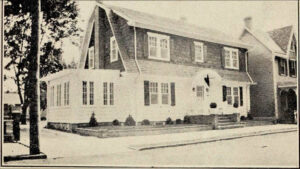
1929-1932 - Rev. James L. Nichols

In 1929 Rev. J. L. Nichols who helped in the tent meetings in 1910 came to serve this church. He and his lovely wife served the church most ably. Because of illness, Rev. Nichols retired after the 1932 Conference. For several years, his son, Herbert Nichols taught in the Milford Schools and helped a great deal with the music at Calvary Church.
1932 -1934 - Rev. Louis C. Randall
Rev. Louis Randall was the minister from 1932 to 1934 . He served the charge well. His daughter's beautiful Church wedding was the second Church wedding in Calvary Church. Miss Emma Hobbs wedding in 1930 was the very first wedding in our church. Most of the weddings at that time took place in the parsonage or at the home of the bride. The Shawnee Methodist Church, west of town, had been a part of the Harrington charge until Rev. Bennett came to Milford; then it became a part of the Milford charge. During this pastorate the Shawnee Church folks came into Calvary and the Shawnee Methodist Church disappeared into history.
1934 – 1939 – Rev. John T. Bailey

From 1934-1939, Rev. J. T. Bailey served the church. In 1935 the Methodist Protestant church of Milford celebrated it's 25th Anniversary.

During this pastorate the Ladies Aid bought a new carpet for the Sanctuary. Deep sorrow came to the parsonage in February 1939 with the death of Mrs. Bailey, a lovely Christian woman. Shortly after her death, Reverend Bailey left Calvary and retired.
1939-1945 - Rev. M. E. Hungerford

Rev. M. E. Hungerford was always available to comfort and encourage those in sorrow and trouble. Mrs. Hungerford, although in poor health, organized a young woman's circle of the Ladies Aid which has furnished much of the leadership of the woman's work since then.
While Rev. Hungerford was here the three branches of Methodist merged in the fall of 1939. The congregation voted to change the name from First Methodist Protestant Church to Calvary Methodist Church.
The debt on the parsonage was finally paid off in 1941. During the depression years it was impossible to pay little more than the interest on the debt. Rev. Hungerford retired on leaving Calvary.
1945-1947 - Rev. Leslie E. Werner

Rev. Leslie E. Werner, a young man of much zeal was a very good organizer. During his years here, 1945-1947, he affected many helpful changes in the church. The Woman's Society of Christian Service was reorganized according to the Guide with circles breaking up every two years. The Youth work was stimulated by a summer visit of a Youth Caravan trained by the Methodist Board of Education in Nashville, Tenn. An oil heating system was installed in the parsonage.
1947-1950 - Rev. David W. Baker

Rev. David W. Baker, came to Calvary Church staying three years, 1947-1950. The Sunday School rooms were renovated and a larger basement room was made for a Fellowship Hall by digging out a basement under the Sanctuary of the church. A new kitchen was made and furnished by the Woman's Society at the cost of $1,000. The walls of the Fellowship Hall were of knotty pine. The total cost of the remodeling and the new furnishings was $40,000, which was being paid for by three year building fund pledges. The opening day for the Sunday School rooms was May 1, 1949. How proud the people of Calvary were of their renovated Sunday School rooms. Mrs. D. W. Baker was a gifted musician and she played the organ and assisted with the choir.
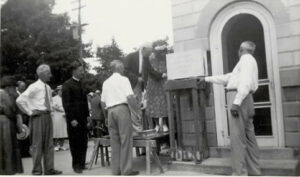

1950-1953 - Rev. Ralph C. Jones

Two years after the renovation in 1949, fire destroyed the entire church on March 3, 1951. Rev. R. C. Jones, the pastor, worked hard to salvage everything from the debris that could be used. Fortunately, the fire insurance policy had been raised from $40,000 to $100,000 just a few months before the church burned. There was still a debt of $18,000 from the remodeling. The Calvary people began another building fund drive, having $82,000 left from the insurance to begin the fund. The church could not be replaced for less than $225,000. Again the women rallied to the cause having many public suppers, to raise money as they had been doing through the years.



1953-1956 - Rev. Donzel C. Wildley

When Rev. D. C. Wildey came to Calvary in 1953 work on the educational unit was progressing rapidly. It was completed and ready for the opening on March 7, 1954. The worship service was held in the large Fellowship Hall on the first floor. The Sanctuary on the floor above was left unfinished until the next fund drive. Over 1700 people attended the four services with 632 at Sunday School, the largest Sunday School Attendance in the history of the church. The people were thrilled by their new church with its up to date units for the Church School educational program.
1956-1965 - Rev. F. Douglas Milbury
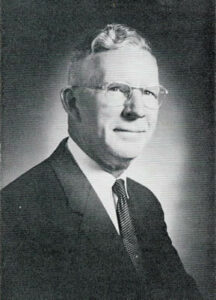
As a small boy, Douglas Milbury came from an orphanage in New York State to live with Mr. and Mrs. John B. Prettyman on a farm in Slaughter Neck. In 1920 he left the farm to study for the ministry. In 1956 Rev. Milbury was coming home after serving several churches in the Peninsula Conference. During his tenure at Calvary, the sanctuary was completed and ready for the consecration service on April 7, 1957. The " was placed above the altar in the new church sanctuary. October 30th through November 6, 1960, the 50" anniversary of Calvary was observed. The Rev. Dr. Roy Tawes was the guest preacher. Rev. Milbury along with his wife Lillian enriched the spiritual life of the Calvary members by starting prayer groups and Bible study groups.
1965-1971 - Rev. Donald O. Clendaniel

On April 23, 1968, The Methodist Church, officially became The United Methodist Church having at that time merged with The Evangelical United Brethren Church. During Rev. Clendaniel’s stay at Calvary the Sunday School continued to expand so that it became necessary once again to plan for further building. As a result Benson Hall, in memory of W. Vernon and Hattie P. Benson was built. In addition to the regular meetings of the church, many other organizations met here. The Milford Rotary Club held their dinner meetings here every week and was served by the United Methodist Women. Other groups included Boy Scout Troop 116 and Cub Scout Pack 116, Girl Scout Troop 777, T.O.P.S., Weight Watchers, Bi-County United Fund and Women's Alcohol Anonymous were a few. Calvary Church was also the collection center for Church World Service. The Heritage Club for persons over 60 met twice weekly.
1971-1974 - Rev. Frederick C. Seyfert
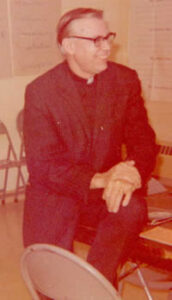
Rev. Frederick C. Seyfert was minister from 1972 to 1974. In 1972, the Draper property which was located in back of the present building was purchased. It was through The Rev. Seyfert's efforts that sufficient funds were raised to pay off the debt of Benson Hall. On June 3, 1973, mortgage burning and dedication of Benson Hall Education Building took place. . Mrs, JoAnn Seyfert was responsible for organizing the Church library which was named the John R. Wilkins Memorial Library. on November 11, 1973, Calvary had a Homecoming Service when all fifty-year members were recognized at the Sunday morning service.
1973-1981 - Rev. Kyle N. Smith

The Rev. Kyle N. Smith was the minister from 1974 to 1981 Funds were raised to pave the parking lot in June of 1974. In 1975, the Stella Poore property was purchased and demolished for additional land. The Chapel was completely refurbished and was dedicated on May 2, 1976.
1981-1988 - Rev. Clarence Hays

During Rev. Hays tenure, the elevator was completed in March of 1982 and was paid for with special donations from members and friends. On October 13, 1985, our 75th Anniversary was observed with a large group of members marching from the Salvation Army parking lot where the tent revival began in 1910 to the present church. They carried banners and the youth group carried 75 balloons which were released when they reached the church.
1981 – 1996 - Rev. James B. Doughten Visiting Minister
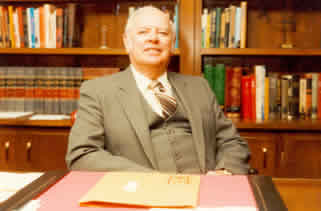
Rev. Doughten’s visits to shut-ins and the sick were greatly appreciated
1988-1995 - Rev. Dr. Laura Martin

From 1988 to 1995, Rev. Dr. Laura A. Martin was the minister. During this time church records were computerized, the lounge and library were refurbished, new furniture was purchased for the Sunday School rooms and numerous other projects that improved the appearance of the church were accomplished.
1995 – 2003 - Rev. Dr. Robert L. Rowe

2003 – 2007 - Rev. Robert W. Kirby, III

2007 - 2008 - Rev. Charles Walters

2008 - 2009 - Rev. Dr. Thomas N. Connar

2009 - 2023 - Rev. Dr. Paul E. Isaacs

